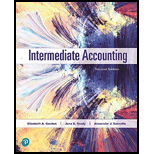
Intermediate Accounting (2nd Edition)
2nd Edition
ISBN: 9780134730370
Author: Elizabeth A. Gordon, Jana S. Raedy, Alexander J. Sannella
Publisher: PEARSON
expand_more
expand_more
format_list_bulleted
Textbook Question
Chapter 9, Problem 9.11Q
What do firms use to record the sales value of a transaction when a note receivable has either an unreasonable rate of interest or no interest rate stated?
Expert Solution & Answer
Want to see the full answer?
Check out a sample textbook solution
Students have asked these similar questions
Financial Accounting
provide correct answer plz
Need answer
Chapter 9 Solutions
Intermediate Accounting (2nd Edition)
Ch. 9 - Prob. 9.1QCh. 9 - Do companies always classify cash as a current...Ch. 9 - Prob. 9.3QCh. 9 - Do accountants typically measure accounts...Ch. 9 - Under the allowance method, will the actual...Ch. 9 - How does an entity record a subsequent recovery of...Ch. 9 - Does the aging of accounts receivable method of...Ch. 9 - What is the difference between pledging accounts...Ch. 9 - How do companies account for receivables that are...Ch. 9 - Is the face value of a note receivable exchanged...
Ch. 9 - What do firms use to record the sales value of a...Ch. 9 - Explain why a company must have highly effective...Ch. 9 - The following are held by YRT Corporation at...Ch. 9 - Fernandez Company had an accounts receivable...Ch. 9 - On its December 31, Year 2, balance sheet, Red...Ch. 9 - Stanberry Company sold 500,000 of net accounts...Ch. 9 - On November 30, Year 1, Derin Corporation agreed...Ch. 9 - Which of the following disclosures about accounts...Ch. 9 - Prob. 9.1BECh. 9 - Prob. 9.2BECh. 9 - Prob. 9.3BECh. 9 - Prob. 9.4BECh. 9 - Prob. 9.5BECh. 9 - Sales Discounts, Most-Likely-Amount Method. On...Ch. 9 - Allowance for Uncollectible Accounts, Write-Off....Ch. 9 - Allowance for Uncollectible Accounts, Write-Off....Ch. 9 - Allowance for Uncollectible Accounts, Recovery....Ch. 9 - Bad Debt Expense, Journal Entry. Paul Anchor...Ch. 9 - Bad Debt Expense. Journal Entry. Paul Anchor,...Ch. 9 - Bad Debt Expense, Aging of Accounts Receivable,...Ch. 9 - Bad Debt Expense, Aging of Accounts Receivable,...Ch. 9 - Prob. 9.14BECh. 9 - Prob. 9.15BECh. 9 - Assigned Receivables. Using the information...Ch. 9 - Factoring Receivables without Recourse. Nicks...Ch. 9 - Prob. 9.18BECh. 9 - Notes Receivable. Welk Associates sold a piece of...Ch. 9 - Prob. 9.20BECh. 9 - Prob. 9.21BECh. 9 - Prob. 9.22BECh. 9 - Internal Controls. Identify whether the following...Ch. 9 - Prob. 9.24BECh. 9 - Prob. 9.25BECh. 9 - Prob. 9.26BECh. 9 - Prob. 9.27BECh. 9 - Prob. 9.28BECh. 9 - Prob. 9.1ECh. 9 - Volume Discounts, Sales Discounts. Sodesta Company...Ch. 9 - Allowance for Uncollectible Accounts, Journal...Ch. 9 - Bad Debt Expense, Aging of Accounts Receivable....Ch. 9 - Bad Debt Expense, Write-Offs, Journal Entry....Ch. 9 - Bad Debt Expense, Aging of Accounts Receivable,...Ch. 9 - Bad Debt Expense, Aging of Accounts Receivable,...Ch. 9 - Bad Debt Expense, Percentage of Accounts...Ch. 9 - Prob. 9.9ECh. 9 - Assigning Receivables, Factoring Receivables....Ch. 9 - Prob. 9.11ECh. 9 - Factoring Receivables with and without Recourse....Ch. 9 - Factoring Receivables without Recourse, Factoring...Ch. 9 - Prob. 9.14ECh. 9 - Prob. 9.15ECh. 9 - Notes Receivable with Year-End Interest Accrual,...Ch. 9 - Prob. 9.18ECh. 9 - Allowance for Uncollectible Accounts, Journal...Ch. 9 - Prob. 9.2PCh. 9 - Allowance for Uncollectible Accounts, Aging of...Ch. 9 - Prob. 9.4PCh. 9 - Bad Debt Expense, Aging of Accounts Receivable....Ch. 9 - Bad Debt Expense, Aging of Accounts Receivable,...Ch. 9 - Prob. 9.7PCh. 9 - Prob. 9.8PCh. 9 - Aging of Accounts Receivable, Write-Offs,...Ch. 9 - Disclosure. Using the transactions listed in P9-9,...Ch. 9 - Accounts Receivable Disclosure. Using Kellogg...Ch. 9 - Prob. 1JCCh. 9 - Financial Statement Analysis Case: Revlon The...Ch. 9 - Prob. 1SSCCh. 9 - Surfing the Standards Case 2: Costs Associated...Ch. 9 - Prob. 1BCC
Knowledge Booster
Learn more about
Need a deep-dive on the concept behind this application? Look no further. Learn more about this topic, accounting and related others by exploring similar questions and additional content below.Similar questions
- Jason Corp. bought equipment for $150,000 on January 1, 2018. Jason estimated the useful life to be 12 years with no salvage value, and the straight-line method of depreciation will be used. On January 1, 2019, Jason decides that the business will use the equipment for a total of 14 years. What is the revised depreciation expense for 2019?arrow_forwardNot use ai solution given answerarrow_forwardhello tutor please help mearrow_forward
arrow_back_ios
SEE MORE QUESTIONS
arrow_forward_ios
Recommended textbooks for you
 Intermediate Financial Management (MindTap Course...FinanceISBN:9781337395083Author:Eugene F. Brigham, Phillip R. DavesPublisher:Cengage Learning
Intermediate Financial Management (MindTap Course...FinanceISBN:9781337395083Author:Eugene F. Brigham, Phillip R. DavesPublisher:Cengage Learning Intermediate Accounting: Reporting And AnalysisAccountingISBN:9781337788281Author:James M. Wahlen, Jefferson P. Jones, Donald PagachPublisher:Cengage Learning
Intermediate Accounting: Reporting And AnalysisAccountingISBN:9781337788281Author:James M. Wahlen, Jefferson P. Jones, Donald PagachPublisher:Cengage Learning Financial Reporting, Financial Statement Analysis...FinanceISBN:9781285190907Author:James M. Wahlen, Stephen P. Baginski, Mark BradshawPublisher:Cengage Learning
Financial Reporting, Financial Statement Analysis...FinanceISBN:9781285190907Author:James M. Wahlen, Stephen P. Baginski, Mark BradshawPublisher:Cengage Learning College Accounting, Chapters 1-27AccountingISBN:9781337794756Author:HEINTZ, James A.Publisher:Cengage Learning,Principles of Accounting Volume 1AccountingISBN:9781947172685Author:OpenStaxPublisher:OpenStax College
College Accounting, Chapters 1-27AccountingISBN:9781337794756Author:HEINTZ, James A.Publisher:Cengage Learning,Principles of Accounting Volume 1AccountingISBN:9781947172685Author:OpenStaxPublisher:OpenStax College

Intermediate Financial Management (MindTap Course...
Finance
ISBN:9781337395083
Author:Eugene F. Brigham, Phillip R. Daves
Publisher:Cengage Learning

Intermediate Accounting: Reporting And Analysis
Accounting
ISBN:9781337788281
Author:James M. Wahlen, Jefferson P. Jones, Donald Pagach
Publisher:Cengage Learning

Financial Reporting, Financial Statement Analysis...
Finance
ISBN:9781285190907
Author:James M. Wahlen, Stephen P. Baginski, Mark Bradshaw
Publisher:Cengage Learning

College Accounting, Chapters 1-27
Accounting
ISBN:9781337794756
Author:HEINTZ, James A.
Publisher:Cengage Learning,


Principles of Accounting Volume 1
Accounting
ISBN:9781947172685
Author:OpenStax
Publisher:OpenStax College
7.2 Ch 7: Notes Payable and Interest, Revenue recognition explained; Author: Accounting Prof - making it easy, The finance storyteller;https://www.youtube.com/watch?v=wMC3wCdPnRg;License: Standard YouTube License, CC-BY